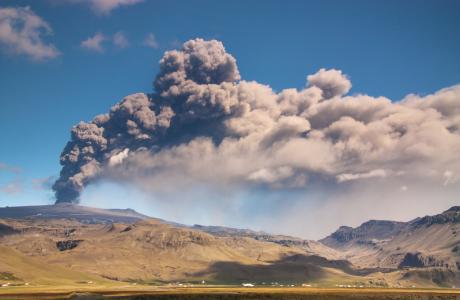
Eyjafjallajökull: How a volcano in Iceland paralyzed aviation
The volcanic eruption in Iceland in 2010 is undoubtedly one of the most remarkable episodes in recent aviation history. While problems with Eyjafjallajökull had previously been limited to pronunciation, the Icelandic volcano catapulted itself into the headlines as it temporarily brought large parts of European air traffic to a standstill. What dangers do volcanic eruptions pose to airplanes? What exactly was the reason why this eruption led to such severe restrictions? And could a similar event happen again?
Contents
General dangers for aircraft due to volcanic eruptions
Although the volcanic eruption in Iceland in 2010 affected air traffic to an unprecedented extent, the fundamental dangers posed by eruptions are generally the same. Ash clouds in particular pose a risk to aviation and can have the following effects:
Material damage due to weight
Even if volcanic ash looks like gray snowfall, it cannot be compared with it. The composition of rock, crystalline material and volcanic glass gives the ash a very high weight, which can quickly lead to considerable damage to machinery or buildings when it falls. However, the ash fall is usually limited to a relatively dense area around the volcano.Turbine damage
If the volcanic ash gets into the engines, it can cause considerable damage. For example, volcanic glass melting at high temperatures can block the cooling of the turbines. Sharp rock particles can also cause physical damage to rotor blades or compressor blades, causing engines to fail.Failure of electronics and measuring devices
Volcanic ash is electrostatically charged. Particularly fine particles can penetrate the electronic components of aircraft and cause failures there. Volcanic ash can also block outward-facing measuring devices and lead to incorrect displays in the aircraft cockpit.Restriction of visibility
Visibility from the cockpit can also be restricted by volcanic ash, especially if the sharp-edged material in the ash cloud cracks the windows. Coupled with possible failures or inaccuracies of the measuring instruments, this can be very dangerous.

Progression of the Eyjafjallajökull eruption in 2010
The eruption of the Eyjafjallajökull volcano began on March 20, 2010 with a comparatively small eruption, which was even smaller than originally predicted by some geologists. Further eruptions followed over the next few days, but initially caused no further problems due to the frequency of volcanoes in Iceland and the resulting familiarity with similar situations. It was not until an explosive eruption on April 14 that around 800 people had to be evacuated. However, even this was not remarkable by international standards. In 2010, the volcanic eruption only achieved a 4 out of 8 on the Volcanic Explosivity Index (VEI).
Nevertheless, it was also this eruption that caused European airspace to be increasingly closed from April 15 - including the airports in Paris and London, while Berlin's airports followed suit on April 16. In the days that followed, air traffic over Europe came to an almost complete standstill at times, which also caused flight cancellations and delays on other continents. Most airspace was reopened on April 21, but there were isolated complications and cancellations into May, particularly in north-western Europe. The volcanic activity at Eyjafjallajökull continued into June.
What was special about the Eyjafjallajökull eruption?
Before Eyjafjallajökull, it seemed hard to imagine that a volcano in Iceland could have such a serious impact on international air traffic. However, due to the geological nature of Iceland, volcanic eruptions are almost a daily occurrence. However, very few of them have anywhere near as great an impact on air traffic as Eyjafjallajökull; the much stronger eruption of the Grímsvötn volcano, also in Iceland, in 2011, for example, resulted in just 900 canceled flights in northern Europe. So what makes this volcano in Iceland so special?
Explosive mixture with glacial ice
Strictly speaking, Eyjafjallajökull refers not only to the volcano, but also to the glacier above it. While the first eruptions occurred to the side of the glacier and therefore not under ice, the eruption on April 14 took place directly under a 200 m thick layer of glacial ice. The water suddenly vaporized by the rising lava caused a much stronger explosion and a correspondingly higher ash cloud.Glass formation
The rising lava cooled very quickly due to the cold glacial ice. This led to a particularly large amount of lava being transformed into volcanic glass. The ash was therefore particularly dangerous for engines due to the high number of sharp glass particles.Jet stream
The Eyjafjallajoküll is located directly under a jet stream, the so-called polar jet, a strong atmospheric air current that particularly supported the distribution of the volcanic ash. In addition, the jet stream was unusually stable at the time of the eruption and continuously blew the ash in a south-easterly direction.
Could other volcanoes have similar effects?
Volcanic activity is not uncommon on Earth. So is there a possibility of airspace closures similar to those caused by Eyjafjallajökull in the near future?
Volcanoes in Iceland
While the volcanic eruption in Iceland in 2010 was by no means the last, and major volcanic activity is still making headlines more than ten years later, this has not yet resulted in another large-scale closure of European airspace. As already explained, the eruption of Eyjafjallajökull brought together several circumstances that are by no means transferable to every volcano in Iceland. However, the Katla volcano, just 25 km away from Eyjafjallajökull, provides similar conditions. This is particularly explosive: Historically, eruptions from Katla have always taken place a few months after Eyjafjallajökull and have been significantly stronger. Although Katla has been active since the volcanic eruption in 2010, no eruption has yet taken place.
Other volcanoes
The volcanoes in Iceland are subject to conditions that are fortunately rarely found in other parts of the world. The proximity to the busy airspace over Western and Central Europe also made the effects of the Eyjafjallajökull eruption so dramatic. Even much larger volcanic eruptions are therefore unlikely to produce similar situations, as their ash clouds, at least in a seriously damaging composition, are not spread so far or over less densely flown areas and can be flown around more easily. Presumably, only an eruption with a VEI of 7 or higher would cause similar or more severe restrictions than the Eyjafjallajo eruption - however, these are extremely rare, with the last eruption of Tambora in Indonesia more than 200 years ago (even larger eruptions are even more than 20,000 years in the past). The most recent level 6 eruption, the Pinatobu eruption in the Philippines in 1991, only caused localized problems for aviation.
Although volcanoes pose a risk to aviation, the effects are generally manageable and serious incidents can be avoided in the vast majority of cases. Eruptions such as that of Eyjafjallajökull in Iceland are extremely rare and will most likely not affect your next trip. With this in mind, we wish you a safe flight!

FAQ
Why is volcanic ash so dangerous for airplanes?
Unlike ordinary ash, volcanic ash is very heavy. It also contains very hard and sharp particles that can severely damage various parts of an aircraft, especially the engines.
Why are airplanes not protected against volcanic ash?
According to current technological standards, this is not possible or at least not economical. However, since the eruption of Eyjafjallajökull, manufacturers have been testing new types of aircraft with regard to the amount of volcanic ash they can safely fly through.
Was the closure of airspace after the eruption of Eyjafjallajökull too drastic?
There is no consensus among experts on this. However, following the eruption of the volcano in Iceland, the limit value for volcanic ash considered critical was first increased to 2 mg per m³ and then 4 mg per m³ by the British aviation authority and aircraft manufacturers - the ash cloud from Eyjafjallajökull would have been significantly below both values in most places.
Can't airplanes fly around the ash clouds?
This is only possible over a very large area. The extremely small volcanic ash particles cannot be accurately detected either by weather radar or by sensors inside the aircraft.
Do other volcanoes pose similar dangers?
Only in rare cases, as the circumstances of Eyjafjallajökull are very special and external factors such as the weather also play a role. The Katla volcano in Iceland, for example, could have similar effects. Other well-known volcanoes such as Stromboli or Vesuvius, but also most of the other volcanoes in Iceland, will most likely not have similar consequences.



